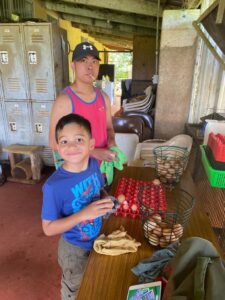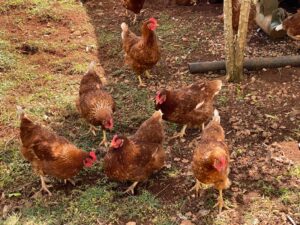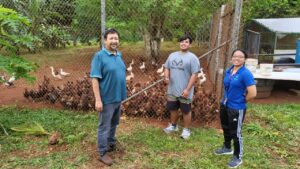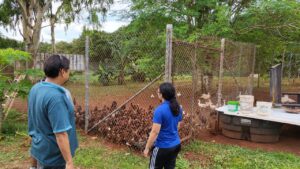Project Overview
Commodities
- Agronomic: barley, grass (misc. annual), oats, potatoes, radish (oilseed, daikon, forage), wheat
- Fruits: apples, bananas, papaya
- Vegetables: cabbages, greens (leafy), sweet potatoes
- Additional Plants: herbs, native plants
- Animals: fish
- Animal Products: eggs
- Miscellaneous: Moringa Leaves, Soursop Leaves,
Practices
- Animal Production: animal protection and health, feed/forage, feed formulation, feed management, feed rations, free-range
- Crop Production: agroforestry
- Education and Training: demonstration, display, farmer to farmer, focus group, mentoring, networking, on-farm/ranch research, technical assistance, youth education
- Farm Business Management: agritourism, apprentice/intern training, community-supported agriculture, cooperatives, farmers' markets/farm stands, labor/employment
- Sustainable Communities: partnerships, public participation, sustainability measures
Proposal summary:
- Summary
 The problem at hand is the expensive importation of commercial poultry feeds that farmers access to sustain their poultry farming. The farmer is proposing a research effort to scale up the preliminary version of poultry local feed at his farm. The project would include utilizing manpower to gather local ingredients on island and processing the feed at the ranch. The research would also prospect the mixture of both imported feeds and local ingredients feed to gauge poultry welfare while feeding on the local feed or the mixture. The controlled, balanced and nutritious diet of the poultry is critical and the research on the local feed and the mixture feed will determine the number of eggs laid and the number of years the poultry will lay eggs for the farmers. The research will include the observation and comparison of the physical characteristics, including weight, of the poultry throughout the project and upon ‘retirement’ when they are harvested for stewing meat. The project is significant because it addresses the possible economical means to support the poultry farming in Guam. The project also does not harm the environment as it is solely focused on the collection and harvesting of local vegetation. The mixture feed would be the infusion of the local mix with the approved imported feeds sold on island. This research would advance sustainable agriculture should the local feed ingredients information be available and shared locally. The local feed project will turn the farm into a demonstration center for students, educators, researchers and farmers to avail information on the production.
The problem at hand is the expensive importation of commercial poultry feeds that farmers access to sustain their poultry farming. The farmer is proposing a research effort to scale up the preliminary version of poultry local feed at his farm. The project would include utilizing manpower to gather local ingredients on island and processing the feed at the ranch. The research would also prospect the mixture of both imported feeds and local ingredients feed to gauge poultry welfare while feeding on the local feed or the mixture. The controlled, balanced and nutritious diet of the poultry is critical and the research on the local feed and the mixture feed will determine the number of eggs laid and the number of years the poultry will lay eggs for the farmers. The research will include the observation and comparison of the physical characteristics, including weight, of the poultry throughout the project and upon ‘retirement’ when they are harvested for stewing meat. The project is significant because it addresses the possible economical means to support the poultry farming in Guam. The project also does not harm the environment as it is solely focused on the collection and harvesting of local vegetation. The mixture feed would be the infusion of the local mix with the approved imported feeds sold on island. This research would advance sustainable agriculture should the local feed ingredients information be available and shared locally. The local feed project will turn the farm into a demonstration center for students, educators, researchers and farmers to avail information on the production.
Project objectives from proposal:
Research Plan:
The project will address the production of local feeds for poultry farming in Guam. Activities will include gathering and collection of locally available alternatives such as sweet potatoes, coconut, fish and agro-industrial by-products grain malt and process to produce local feeds. Another activity will be to combine the local feed ingredients with imported feeds to observe poultry welfare when fed on both feeds or just the local feeds.
The chicken flock will be divided into three groups. A selected 20 of the chicken flock will be considered the control group and fed only with imported commercial feed. Another selected 20 of the flock will be fed with locally available feeds as previously described and the final third of the flock will be fed with a 50% mixture of imported commercial feed and locally available feed.
A period of 30-60 days will produce results which can be gauged. There will be a record keeping on the poultry feeding preferences, physical activities and overall welfare including weight tracking. There will be feeding measuring cups to capture the amount of feeds that is fed to the selected flocks each day and captured through record keeping along with scaling the poundage of the feeds on a weekly basis. Egg production will be monitored on weekly basis and the eggs size, weight and egg quality will be measured. The thickness of the egg shells will be observed and recorded as well.
The farmer [PI] will be accountable for performance objectives. He will supervise all activities relating to the project from the collection and gathering of local ingredients to the mixing and processing of the feeds. He will also supervise the mixture feeding for the poultry and document poultry reaction, preferences and general welfare.
The goal for the project is to seek an alternative approach to sustaining a poultry farming endeavor. The preliminary version for the local feeding on-site at the farm although is in its pilot states has its highlight in that it economizes the feeding approach for the poultry farm and if maximized will change the approach to poultry farming. The approach discussed in this proposal can be supported if the farm also invest into growing the ingredients vegetation around the farm. In this instance, the farmer does cultivate vegetables and fruits which are ingredients in the local feeds and partners with local businesses to gather agro-industrial by-products grain malt to add-on to the local feeds. The farm team will continue this approach and do record keeping to share and enlarge this approach with other farmers, including the cost effectiveness of gathering local feeds relative to the purchase of imported commercial feed. The team will also approach a trade scheme with non-poultry farmers to entice partnership through exchange of goods and plant growth that can secure supplies to continue the local food processing when vegetable or fruits are low.
[Photo Above: Rancher/Farmer Tommy Tanaka Jr with Agriculture Students from Univ. of Guam]
First 60-90 Days: PI and Farm Team plan and implement local feed ingredients gathering
First 30-90 Days: Planting and Continuity of farm vegetation for supporting ingredients.
First 30-120 Days: Farm Team collecting local ingredients for the local feed processing.
First 30-120 Days: Farm Team feeding poultry with local feeds and mixed feeds for observation and documentation.
Remaining Time Frame for the Project: Planning, Scheduling and Implementing the Demonstration for the Local Feeding Processing at the Farm [inclusion of researchers, students, educators, farmers and interest groups].
Education Plan:
The farm will be the demonstration site for the proposed project of producing poultry local feeds. Students, Educators, Researchers, Farmers and interest group are welcomed observers and participants for the gathering, planting and processing of the local feeds. At the demonstration site, there will be an attendance sheet that will collect names, dates of visit, occupations, age group, gender, and organizations represented. There will also be short fact sheet on the project and the farm’s operational objectives. The demonstration center will also sign up to a social media app to mass announce the project and capture numbers of visitors and comments pertaining to the project. The social media app will also allow for live feeds at the demonstration center during field trip visits and other events at the farm. The demonstration center will be managed and operated by the farmer [PI] and the farm team. Field trips, eco-tourism, and safe farming activities will be planned and carried out to involve stakeholders and interested groups. There will be at least 2 farm sponsored events to invite any interested age group, individuals, gender, organizations or non-residents of Guam to visit, observe and participate in the local feed production. The farm if necessary, will invite volunteers to translate information to those who do not speak or understand English. The farm has operated for a few years and with this new approach, it is strongly believed that a new interest will be sparked to learn and or support this undertaking amongst the existing farmers and the new incoming farmers in the future.
The educational aspect of this project will be based on students’ availability days for field trips. There will be quarterly demonstrations at the farm and upon request from interested individuals, researchers, farmers or groups during the project life and will be ongoing long after the project funding support terminates.


